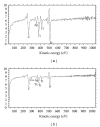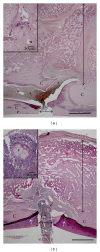In vivo caprine model for osteomyelitis and evaluation of biofilm-resistant intramedullary nails
- PMID: 23841085
- PMCID: PMC3693125
- DOI: 10.1155/2013/674378
In vivo caprine model for osteomyelitis and evaluation of biofilm-resistant intramedullary nails
Abstract
Bone infection remains a formidable challenge to the medical field. The goal of the current study is to evaluate antibacterial coatings in vitro and to develop a large animal model to assess coated bone implants. A novel coating consisting of titanium oxide and siloxane polymer doped with silver was created by metal-organic methods. The coating was tested in vitro using rapid screening techniques to determine compositions which inhibited Staphylococcus aureus growth, while not affecting osteoblast viability. The coating was then applied to intramedullary nails and evaluated in vivo in a caprine model. In this pilot study, a fracture was created in the tibia of the goat, and Staphylococcus aureus was inoculated directly into the bone canal. The fractures were fixed by either coated (treated) or non-coated intramedullary nails (control) for 5 weeks. Clinical observations as well as microbiology, mechanical, radiology, and histology testing were used to compare the animals. The treated goat was able to walk using all four limbs after 5 weeks, while the control was unwilling to bear weight on the fixed leg. These results suggest the antimicrobial potential of the hybrid coating and the feasibility of the goat model for antimicrobial coated intramedullary implant evaluation.
Figures








Similar articles
-
Silver ion doped ceramic nano-powder coated nails prevent infection in open fractures: In vivo study.Injury. 2016 Feb;47(2):320-4. doi: 10.1016/j.injury.2015.10.006. Epub 2015 Oct 21. Injury. 2016. PMID: 26589596
-
Antibacterial and Biocompatible Titanium-Copper Oxide Coating May Be a Potential Strategy to Reduce Periprosthetic Infection: An In Vitro Study.Clin Orthop Relat Res. 2017 Mar;475(3):722-732. doi: 10.1007/s11999-016-4713-7. Clin Orthop Relat Res. 2017. PMID: 26847453 Free PMC article.
-
Gentamicin coating of plasma chemical oxidized titanium alloy prevents implant-related osteomyelitis in rats.Biomaterials. 2016 Sep;101:156-64. doi: 10.1016/j.biomaterials.2016.05.039. Epub 2016 Jun 2. Biomaterials. 2016. PMID: 27294535
-
Review of titanium surface modification techniques and coatings for antibacterial applications.Acta Biomater. 2019 Jan 1;83:37-54. doi: 10.1016/j.actbio.2018.10.036. Epub 2018 Oct 26. Acta Biomater. 2019. PMID: 30541702 Review.
-
Prophylaxis and treatment of implant-related infections by antibiotic-coated implants: a review.Injury. 2006 May;37 Suppl 2:S105-12. doi: 10.1016/j.injury.2006.04.016. Injury. 2006. PMID: 16651063 Review.
Cited by
-
Silver Carboxylate as an Antibiotic-Independent Antimicrobial: A Review of Current Formulations, in vitro Efficacy, and Clinical Relevance.Med Res Arch. 2022 Dec;10(12):10.18103/mra.v10i12.3388. doi: 10.18103/mra.v10i12.3388. Epub 2022 Dec 21. Med Res Arch. 2022. PMID: 36874620 Free PMC article.
-
Role of Animal Models to Advance Research of Bacterial Osteomyelitis.Front Vet Sci. 2022 Apr 26;9:879630. doi: 10.3389/fvets.2022.879630. eCollection 2022. Front Vet Sci. 2022. PMID: 35558882 Free PMC article. Review.
-
A systematic review on current osteosynthesis-associated infection animal fracture models.J Orthop Translat. 2020 Mar 30;23:8-20. doi: 10.1016/j.jot.2020.03.002. eCollection 2020 Jul. J Orthop Translat. 2020. PMID: 32440511 Free PMC article. Review.
-
Silver carboxylate-TiO2/polydimethyl siloxane is a safe and effective antimicrobial with significant wound care potential.OTA Int. 2024 Mar 11;7(2 Suppl):e299. doi: 10.1097/OI9.0000000000000299. eCollection 2024 Mar. OTA Int. 2024. PMID: 38487399 Free PMC article.
-
Biocompatibility Analysis of the Silver-Coated Microporous Titanium Implants Manufactured with 3D-Printing Technology.Nanomaterials (Basel). 2024 Nov 22;14(23):1876. doi: 10.3390/nano14231876. Nanomaterials (Basel). 2024. PMID: 39683264 Free PMC article.
References
-
- Hayda RA, Mazurek MT, Powell ET, IV, et al. From Iraq back to Iraq: modern combat orthopaedic care. Instructional course lectures. 2008;57:87–99. - PubMed
-
- Murray CK, Hsu JR, Solomkin JS, et al. Prevention and management of infections associated with combat-related extremity injuries. The Journal of trauma. 2008;64(3, supplement):S239–S251. - PubMed
-
- Gustilo RB, Mendoza RM, Williams DN. Problems in the management of type III (severe) open fractures: a new classification of type III open fractures. Journal of Trauma. 1984;24(8):742–746. - PubMed
-
- Gustilo RB, Gruninger RP, Davis T. Classification of type III (severe) open fractures relative to treatment and results. Orthopedics. 1987;10(12):1781–1788. - PubMed
-
- Patzakis MJ, Wilkins J. Factors influencing infection rate in open fracture wounds. Clinical Orthopaedics and Related Research. 1989;(243):36–40. - PubMed
Publication types
MeSH terms
Substances
LinkOut - more resources
Full Text Sources
Other Literature Sources
Medical

